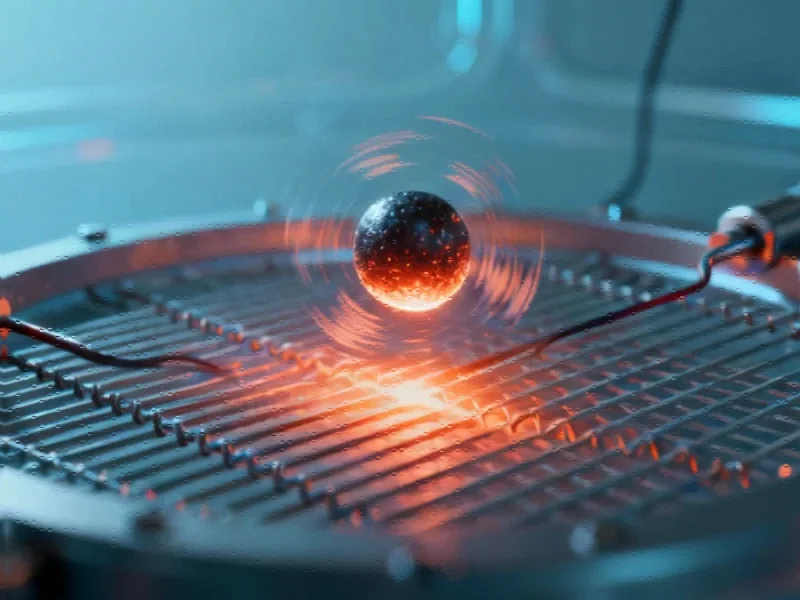Surface-Mediated Quantum Entanglement Breakthrough
Researchers have demonstrated a novel approach to generating steady-state quantum entanglement between atomic emitters using Casimir-Polder interactions near material surfaces, according to a recent study published in Scientific Reports. The findings reportedly reveal how specific surface configurations can maintain quantum correlations indefinitely, potentially advancing quantum computing and quantum memory technologies.
Table of Contents
Quantum Dynamics and Steady-State Formation
Sources indicate that the research team analyzed the dynamics of quantum emitters positioned at equal distances from a surface, governed by a master equation that describes their quantum mechanical behavior. The system reportedly evolves from an initial uncorrelated state into an entangled steady state where quantum correlations persist indefinitely. Analysts suggest this occurs when the relative decay parameter approaches zero, creating a balance between spontaneous emission and surface-mediated dipole-dipole interactions.
The report states that the key to this phenomenon lies in the emergence of a subradiant state where emitters become decoupled from the electromagnetic field. According to calculations, this state yields a concurrence value of approximately 0.5, quantitatively measuring the degree of entanglement between the two quantum systems.
Dipole Configuration Critical to Success
Researchers examined two distinct dipole orientations relative to the surface: perpendicular (zz) and parallel (xx) configurations. The analysis reportedly shows that the parallel (xx) configuration maintains entanglement significantly longer than the perpendicular arrangement. Sources indicate that in the xx configuration, the entanglement persists for extended periods, while in the zz configuration, it decays to zero much more rapidly.
The report explains this difference through the dipole-image model, where a perfect conductor surface acts as a mirror. When dipoles are parallel to the surface, their fields and image fields tend to cancel each other, creating a near-zero field environment that minimizes decay. Conversely, perpendicular dipoles experience reinforced fields that accelerate decay.
Surface Material Impacts Entanglement Quality
According to the research, the team extended their analysis to different surface materials, including perfect conductors, gold surfaces modeled using the Drude model, and superconducting niobium surfaces. The findings reportedly demonstrate that superconducting surfaces behave similarly to perfect conductors, maintaining near-zero relative decay and enabling nearly steady-state entanglement.
Analysts suggest that metal surfaces with non-zero loss parameters present a more challenging environment for entanglement preservation. The report states that near gold surfaces, entanglement decays quickly due to significant surface scattering in the non-retarded regime. However, researchers identified an optimal distance from gold surfaces where relative decay is minimized and entanglement maximized.
Practical Applications and Future Directions
The study utilized silicon-vacancy centers embedded in nanodiamonds as quantum emitters, with a transition wavelength of approximately 737 nanometers. Sources indicate that the system demonstrates how quantum technologies could leverage surface effects to maintain entangled states.
While achieving exact zero relative decay may not be practically feasible, the research suggests that significant entanglement can be maintained for extended periods even with non-zero relative decay values. According to calculations, entanglement near perfect conductor and superconducting surfaces reaches approximately 0.48 and 0.45 respectively, compared to 0.25 in free space and significantly reduced values near metal surfaces at certain distances.
The findings reportedly provide a framework for designing quantum systems that utilize surface interactions to preserve quantum coherence, potentially enabling more stable quantum computing operations and quantum memory storage. Researchers suggest that further investigation into different material interfaces and geometric configurations could yield even more efficient entanglement preservation methods.
Steady state |
Density matrix |
Master equation
Related Articles You May Find Interesting
- Microsoft’s Surface Laptop With Snapdragon X Elite Sees Major Pre-Black Friday D
- UK Tribunal Rules Apple Abused App Store Dominance, Faces Potential $2 Billion P
- Samsung Reportedly Shifts Galaxy S26 Plus Production Timeline to January 2026
- UK Government Greenlights Major 474-Acre Solar Farm Project in Kent
- Quantum Sensing Firm Expands with Berlin Photonics Spin-Off Focused on Micro-Int
References
- http://en.wikipedia.org/wiki/Perfect_conductor
- http://en.wikipedia.org/wiki/Density_matrix
- http://en.wikipedia.org/wiki/Steady_state
- http://en.wikipedia.org/wiki/Master_equation
- http://en.wikipedia.org/wiki/Dipole
This article aggregates information from publicly available sources. All trademarks and copyrights belong to their respective owners.
Note: Featured image is for illustrative purposes only and does not represent any specific product, service, or entity mentioned in this article.



